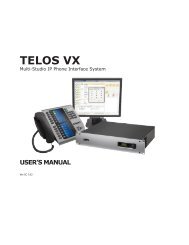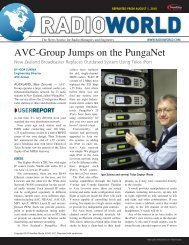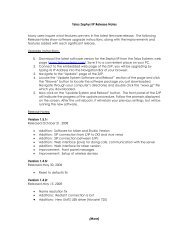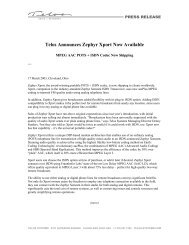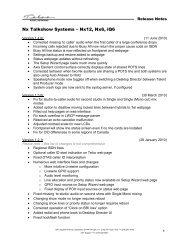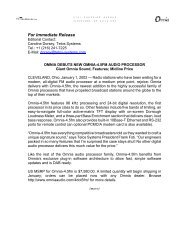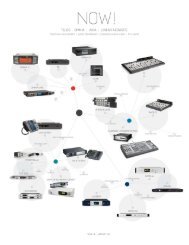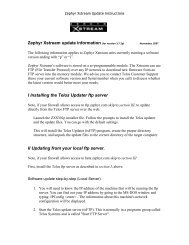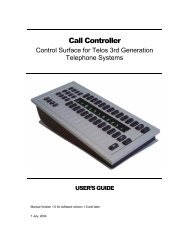Hx1-Hx2 Manual-1.4.1 - Telos
Hx1-Hx2 Manual-1.4.1 - Telos
Hx1-Hx2 Manual-1.4.1 - Telos
Create successful ePaper yourself
Turn your PDF publications into a flip-book with our unique Google optimized e-Paper software.
TelepHone TerMInoloGy GuIDe | A13<br />
physical interface between a Switch and a Line or Trunk or “line equipment”. Product literature<br />
often refers to the number of ports on a phone system. In this context it refers to the number of<br />
phones or lines (or sometimes the combination) the system supports.<br />
POT- Plain Old Telephone. A black, rotary-dial desk phone. Usually a Western Electric model<br />
500 set. Outdated term.<br />
POTS – Plain Old Telephone Service. Regular old-fashioned analog loop start phone service.<br />
PRI – ISDN Primary Rate Interface- A form of ISDN with 23 “B Channels” and one “D<br />
channel”. All 24 channels are on a single cable. Functionally related to T1 telephone circuits.<br />
In Europe PRI has 30 “B Channels” and one “D Channel” and one “Sync channel”. See also B<br />
channel and D channel.<br />
Provisioning -The act of configuring a telecommunications service. Also refers to the complete<br />
line configuration information.<br />
RBOC- Regional Bell Operating Company. Most often called Local Exchange Carriers<br />
(LEC’s) at the time of this writing. See CLEC and LEC.<br />
RCF – Remote Call Forwarding, a telephone company service that provides local “virtual numbers”<br />
from distant locations. Customers are responsible for the cost of calls forwarded though he<br />
RCF number. VoIP service providers can offer similar services a greatly reduced costs since the<br />
numbers are delivered via the Internet (“backhauled”) at no cost.<br />
RD- Receive Data. Data coming from the network, or DCE towards the DTE. Also, a light on<br />
a modem or CSU/DSU that lights to indicate presence of this signal.<br />
Red Alarm- An alarm state on a T-carrier circuit that indicates that the incoming signal (at<br />
the network interface) has lost frame for more than a few seconds. Normally a Yellow alarm is<br />
then returned (i.e. sent back) if a Red alarm is present. A Red Alarm indicates a loss of inbound<br />
signal; a Yellow alarm indicates (indirectly) a loss of outbound signal. See also Yellow alarm,<br />
Blue alarm, and LOS.<br />
Regional Bell Operating Company- See RBOC or LEC.<br />
Repeater- A device intended to extend ISDN telephone service to sites further from the central<br />
office than could normally be served. i.e.: beyond 18,000 feet. ISDN repeater technologies<br />
include “BRITE”, “Virtual ISDN”, “Lightspan”, and “Total Reach”. Some Telcos do not use<br />
repeaters. Compatibility between a given NT1 (CPE) and a repeater is less certain than if that<br />
CPE where directly connected to the switch.<br />
Robbed Bit Signaling- A signaling scheme that “borrows” bits on each T1 channel for use as<br />
signaling channels. On SF T1’s there are two bits, the A bit and the B bit in each direction. On<br />
ESF T1’s there is also a C and D bit in each direction, although they are rarely used. Using these<br />
bits, various older analog trunk interfaces can be emulated over a T1. For instance, dial pulse<br />
address signaling using 10 pulse per second (rotary style) digit groups over these bits. Since<br />
robbed bit signaling interferes with the least significant bit, only 7 bits can be used for sensitive<br />
data applications, leaving only a 56kbps channel for data applications. See also CAS and CCIS.<br />
Rollover – See Hunt Group.<br />
SDSL - SDSL is a rate-adaptive Digital Subscriber Line (DSL) variant with T1/E1-like data<br />
rates (T1: 1.544 Mbps, E1: 2.048 Mbps). It runs over one pair of copper wires, with a maximum<br />
range of 10,000 feet. It cannot co-exist with a conventional voice service on the same pair as it<br />
utilizes the entire bandwidth or the subscriber loop.<br />
Sealing Current- Unlike telegraphy, teletypewriter and POTS lines, most digital lines (such as<br />
ISDN) use a voltage rather than current mode of operation. Sealing Current allows a controlled



